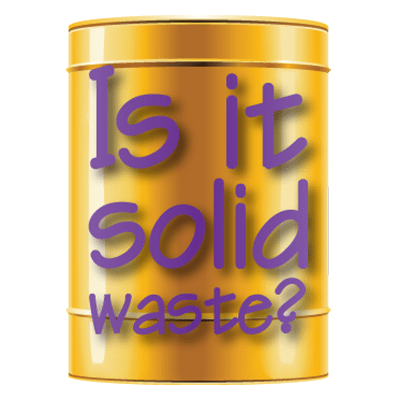
40 CFR defines solid waste as “any discarded material that is not excluded under §261.4(a) or that is not excluded by a variance granted under §260.30 and §260.31 or that is not excluded by a non- waste determination under §260.30 and §260.34.” Additionally, discarded material is, “any material which is: (A) Abandoned… (B) Recycled…(C) Considered inherently waste-like, …or (D) A military munition identified as a solid waste in §266.202.” This makes everything perfectly clear, right? Relative fuzziness aside, what I want to talk about today is the 40 CFR 261.2 recycling exemptions as they relate to solid wastes.
There are five types of material that can be considered for recycling exemptions:
- Spent materials – The EPA defines spent materials as “any material that has been used and as a result of contamination can no longer serve the purpose for which it was produced without processing.”
- Sludges – According to the EPA, a sludge is “any solid, semi-solid, or liquid waste generated from a municipal, commercial, or industrial wastewater treatment plant, water supply treatment plant, or air pollution control facility exclusive of the treated effluent from a wastewater treatment plant.”
- Byproducts – “A byproduct is a material that is not one of the primary products of a production process and is not solely or separately produced by the production process. Examples are process residues such as slags or distillation column bottoms. The term does not include a co-product that is produced for the general public’s use and is ordinarily used in the form it is produced by the process.”
- Commercial chemical products – These products are not being used but have not been spent for an intended purpose.
- Scrap metal
These five materials can have recycling exemptions in four different ways:
- Use constituting disposal – Used in a manner constituting disposal
- Burning waste or waste fuels for energy recovery or using wastes to produce a fuel.
- Reclamation of wastes – According to the EPA, “A material is reclaimed if it is processed to recover a usable product, or if it is regenerated. Examples are recovery of lead values from spent batteries and regeneration of spent solvents.”
- Speculative accumulation – This is one of the more detailed recycling exemptions. According to the EPA, “A material is accumulated speculatively if it is accumulated before being recycled. A material is not accumulated speculatively, however, if the person accumulating it can show that the material is potentially recyclable and has a feasible means of being recycled; and that—during the calendar year (commencing on January 1)—the amount of material that is recycled, or transferred to a different site for recycling, equals at least 75 percent by weight or volume of the amount of that material accumulated at the beginning of the period.” More information about this can be found in 40 CFR §261.1.
Recycling exemptions are just a small portion of possible exceptions. Always check 40 CFR and state regulations for full information.
More News From Heritage
-
1/7/25
Navigating e-Manifest: What You Need to Know About Hazardous Waste Compliance
Learn about the e-Manifest Third Rule changes that begin January 22, 2025
-
12/23/24
Wreaths Across America 2024
This year, through collective effort and heartfelt generosity, we sponsored 727 wreaths and transported two truckloads of wreaths across the country.
-
12/2/24
Heritage Environmental Services Announces Rachel Evans as Chief Human Resources Officer
Heritage Environmental Services announced today that Rachel Evans will join the organization as Chief Human Resources Officer.
-
11/26/24
Honoring Teresa Wade: A Legacy of Dedication to Wreaths Across America
Celebrate Teresa Wade's legacy at Heritage Environmental and her dedication to Wreaths Across America. Learn her story and how you can honor veterans
-
11/14/24
Bright Futures Begin Lead-Free: Reducing Lead Exposure Together
Learn about lead decontamination, disposal processes, and join us in creating a lead-free future.
-
11/11/24
Celebrating Our Veterans at Heritage Environmental Services
-
10/31/24
Heritage Environmental Services Secures Commercial Permit Status for Orange, TX Incinerator
Learn more about Heritage Environmental Services securing a commercial permit for its Orange, TX incinerator, expanding waste disposal solutions.
-
10/14/24
Heritage Environmental Services Announces Timothy Thomas as Chief Operating Officer
Heritage Environmental Services (“HES”), an EQT Infrastructure portfolio company, announced today that Timothy Thomas will join the organization as Ch








